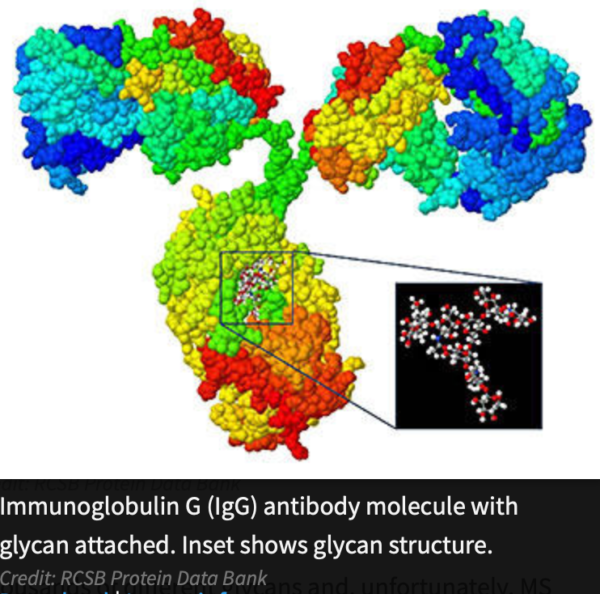Glycan Arrays:
A glycan array is a high-throughput screening platform used to study the interactions between carbohydrates (glycans) and other molecules, such as proteins, antibodies, or cells. It involves immobilizing a large number of different glycans onto a solid support, such as a glass slide or a microarray chip, in a spatially defined manner.
Glycans are complex sugar molecules that are present on the surface of cells and play crucial roles in various biological processes, including cell-cell recognition, immune responses, and signaling events. Glycan arrays enable researchers to systematically investigate the binding specificities and preferences of glycan-binding proteins (such as lectins) or other molecules towards different glycans.
The construction of a glycan array typically involves synthesizing or isolating a diverse set of glycans and attaching them to the solid support. This can be done using various techniques, including chemical conjugation, enzymatic reactions, or printing methods. The resulting array contains multiple spots, each representing a different glycan structure.
To study the interactions, the glycan array is then incubated with a target molecule, such as a protein or an antibody. If the target molecule has affinity for a specific glycan, it will bind to the corresponding spot on the array. The binding events can be detected and quantified using different labeling or detection methods, such as fluorescent tags or radioactive probes.
By screening a large number of glycans simultaneously, glycan arrays provide valuable information about the binding preferences and selectivity of glycan-binding proteins. They can help identify specific glycan structures that are recognized by certain proteins, characterize glycan-protein interactions, and investigate the roles of glycans in various biological processes, including disease-related mechanisms.
Overall, glycan arrays are powerful tools for glycomics research, enabling a comprehensive analysis of glycan-protein interactions and facilitating the discovery of new biomarkers, therapeutic targets, and diagnostic tools.

If you are new to glycobiology and wish to get started with glycan arrays, I highly recommend a YouTube video primer by Professor Carolyn Bertozzi (now at Stanford U). https://www.ibiology.org/biochemistry/glycans/
You may already know that glycan arrays enable the high-throughput study of the interactions between macromolecules, such as viruses, bacteria, proteins, lectins, and carbohydrates. This is well suited to profile the binding specificities of antibodies or analyze glycan antigens present in serum. Combined with label-free detection, glycan arrays utility increases further, as no detection scheme need to be employed. In cases where a special surface is needed, fluorometric detection of labeled biomolecules can also be used.

Now that synthetic glycans are readily available, it is possible to construct glycan microarrays for specific purposes. They can be used to study hundreds of protein interactions in a single experiment, thus conserving often precious biological samples.
They can be constructed using non-covalent or covalent immobilization approaches. For non-covalent modes, needed for unmodified glycans, hydrophobic or electrostatic interactions are leveraged. Nitrocellulose or lysine-coatings for unmodified glycans, or streptavidin coated surfaces for biotin-tagged glycans. Covalent attachment can be achieved with amino-tagged glycans reacting with NHS, epoxy, or aldehyde surfaces, and with thiol-tags, gold surfaces can be used. One of the latest techniques makes use of so called ‘click-chemistry’, reacting azide with alkyne groups. For unmodified glycans, covalent attachment is possible using hydrazide surface coatings.
The classical detection modality involves the use fluorescent-tagged biomolecules, such as Cy3-coupled glycan binding proteins (GBP) or antibodies. The magnitude of the fluorescence signal correlates with the extent of biomolecular binding. While surface plasmon resonance (SPR) has been used, the new iris technology is particularly better suited for these arrays.
Glycan arrays can also be used to capture, identify, and quantify a wide range of entities, such as proteins, viruses, and cells. Vaccine development is an example application where glycan arrays shine. Since cancer cells often exhibit a modified glycan profile on their surfaces, glycan arrays can be used to explore diagnostics, and treatment effectiveness.
An excellent review article can be found here. There’s also a good review article by Prof Richard Cummings.
A new book on glycoscience is also just coming out now,
Existing references on the topic make use of older spotting technologies for the production of the arrays. In recent years, newer and faster spotters make for better choices if building this capability in-house. Alternatively, microarrays can be produced as an outsourced service.

